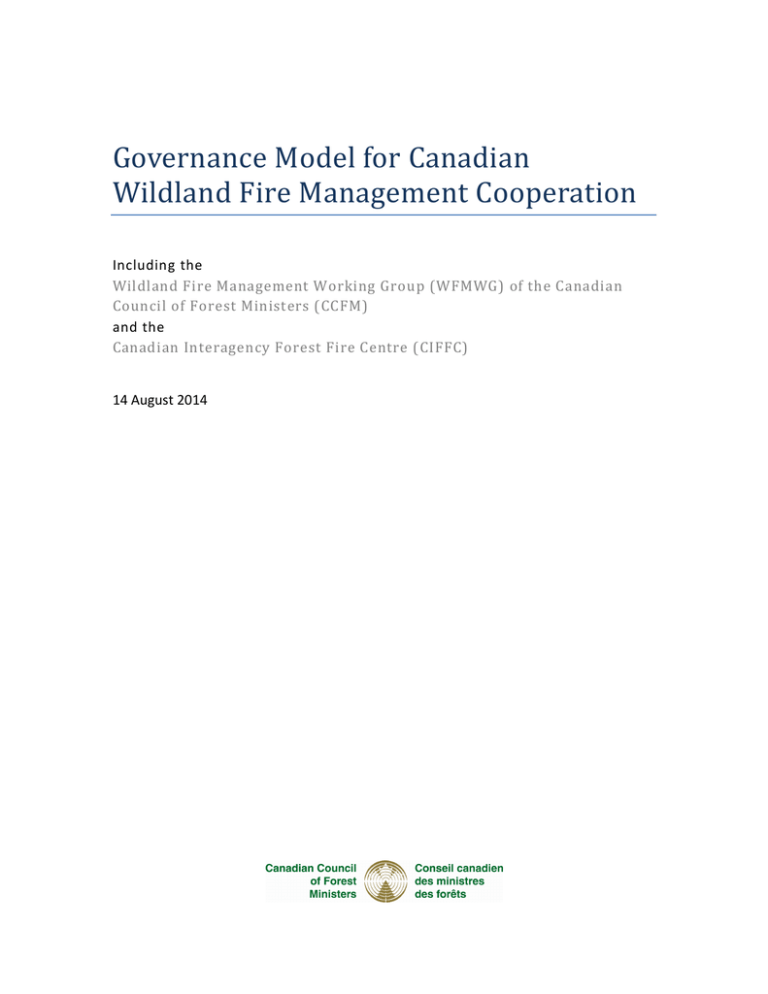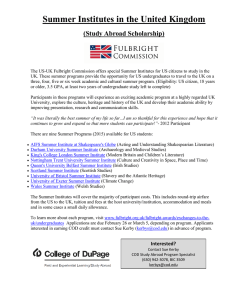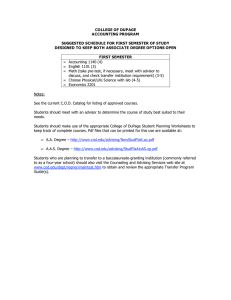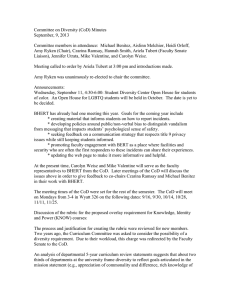Governance Model for Canadian Wildland Fire Management
advertisement

GovernanceModelforCanadian WildlandFireManagementCooperation Including the Wildland Fire Management Working Group (WFMWG) of the Canadian Council of Forest Ministers (CCFM) and the Canadian Interagency Forest Fire Centre (CIFFC) 14 August 2014 Table of Contents Background ................................................................................................................................. 2 Summary of Roles ....................................................................................................................... 2 Governance Structure ................................................................................................................. 3 Governance Goals ....................................................................................................................... 4 Goal 1: Streamline working structures to improve clarity and accountability, reduce overlap and gaps. ................................................................................................................................. 4 Goal 2: Improve communication among all levels .................................................................... 5 Goal 3: Ensure consistent and standardized project management, reporting, and accomplishment of priorities. .................................................................................................. 5 Goal 4: Clear direction and prioritization of work..................................................................... 6 Goal 5: Administer Funds and Ensure Accountability for Accomplishment ............................... 7 Appendix 1: Recommended Organization Structure (Working Level) ........................................... 8 Appendix 2: 2013 List of Working Groups, Communities of Practice, Task Teams & Projects ........ 9 Appendix 3: Old Working Group, Community of Practice and Task Team descriptions ............... 10 Appendix 4: Background to Governance Discussion ................................................................... 11 Page 1 Background The WFMWG and CIFFC structures have been working together for a number of years. In the fall of 2013 a decision was made to clarify and improve governance of cooperative work across the country to make best use of available resources, achieve current strategic priorities, and set the stage for future success in dealing with the challenges facing fire managers. Funding for the joint Canadian wildland fire management projects is provided by both the CCFM and CIFFC through their established financial networks. A governance model describes the roles that participants take on and the process for decision making. It also describes the ground rules for participation in projects and the processes for communicating and sharing within the community. Governance sets the tone for the culture of how the organization gets things done. In the fall of 2013, the WFMWG established a governance task team (TT) to improve financial management, project management and business management including oversight and reporting of the WFMWG. The 2013-2018 CIFFC Strategic Plan established improved governance as an immediate priority. This Governance Model has been designed considering the current (2013/14) strategic priorities of both the WFMWG and CIFFC. Summary of Roles The Wildland Fire Management Working Group (WFMWG) and the CIFFC Board of Trustees (BoT) are comprised of Assistant Deputy Ministers (ADM’s) of all of the Canadian provinces and territorial ministries which manage forest fires and an ADM representing the Canadian Forestry Service (CFS). These ADMs are accountable, through their Deputy Ministers, to the Canadian Council of Forest Ministers. The WFMWG and BoT are the same ADM’s with the same accountabilities for wildland fire in Canada. The distinction between the WFMWG and BoT roles are that the WFMWG is designed to provide strategic leadership to wildland fire issues and policy in Canada. The WFMWG is designed to connect the strategic WFM priorities to the Deputies and Ministers of the CCFM. The BoT role has been in place much longer (since 1982) to ensure fiduciary and legal oversight of the corporation of CIFFC. In summary, the role of the ADMs is to provide strategic direction, fiduciary and legal oversight, and to connect wildland fire issues with political and senior levels of government. The Council of Directors (CoD or CIFFC Council of Directors) are: the directors of all of the Canadian agencies which manage forest fires1; a Director from the CFS; and the Director of CIFFC. The CoD includes one director reporting to each of the ADMs in the WFMWG/BoT and are responsible to set strategic direction, share and develop best practices, and ensure the workplan is accomplished. From the CoD perspective, the description of governance below must include 1 The CoD includes the Director of SOPFEU and a Director representing Parks Canada who are represented on the WFMWG/BoT by Quebec and the CFS, respectively Page 2 detail pertaining to decision making, project management, and communication that is not the focus of the ADM’s. Starting in 2014, the whole of the CoD will take on the role of supporting the ADM’s in their capacity as the WFMWG. A former sub-group of the CoD, known as the “Oversight Team”, will be disbanded. The CIFFC non-profit corporation is responsible to all of the member provinces and territories and Canada to facilitate Canadian resource sharing (described in the MARS agreement – especially during summer months), standards that support resource sharing (equipment, air operations, training, information) and to facilitate the broad community of practice that supports effective fire management across Canada. CIFFC is also available to provide administrative (secretariat) support to the common interests of the members. That is, CIFFC is available to serve the overall goals of the member agencies. CIFFC staff in Winnipeg has a key role in facilitating working groups and tasks, project management, and reporting and information structures. But they are not the sole source of this leadership. Members of the broader WFM community will be directly involved in leadership of CIFFC work. Governance Structure Page 3 Governance Goals Goal 1: Streamline working structures to improve clarity and accountability, reduce overlap and gaps. This goal will be accomplished by: Implementing the organization structure described in Appendix 1. CIFFC will broaden the scope of Working Groups (WG) to include all aspects of Wildland Fire Management. That is, all Canadian wildland fire management cooperation will flow through the CoD and WG structure.2 The CoD will manage work through fewer, more comprehensive WG’s that cover strategic issues. To streamline and improve communications, many Working Groups and Task Teams will report to a few standing Working Groups that report to the CoD. All subgroups will be either Working Groups 3 or Task Teams: o A Working Group has an ongoing role and the CoD will be able to place most projects and issues with one of the WGs for analysis and recommendations. Working groups will manage many projects, will share best practices, and may have other Working Groups or Task Teams reporting to them. o Task Teams are formed to accomplish time-limited projects that can be completed under one Project Charter. The CoD will support staff who volunteer for WG or TT assignments and Directors are accountable to the CoD for the time commitment required to accomplish projects on time. The CoD will directly form or lead a small number of Task Teams (e.g., to accomplish strategic projects such as renewal of the revenue model, governance, Strategic Planning.) Working groups are normally comprised of representatives from all provincial, territorial and federal fire management agencies, and have an ongoing role in setting standards for resource or information sharing (a core CIFFC function). Working Groups and Task Teams may include persons from outside CIFFC members (e.g., academia, other government agencies) based on an interest and need for additional expertise. 2 At one time, the focus of CIFFC was primarily resource sharing. At one time, the focus of the WFMWG and the (disbanded) Oversight Team was on implementation of the goals of the Canadian Wildland Fire Strategy (2005) and provide strategic advice to the CCFM. This distinction is no longer required, and the community should focus on all aspects of wildland fire management cooperation. 3 The distinction of a group being a Community of Practice will be discontinued. All ongoing groups will be referred to as Working Groups. Page 4 Working Groups and Task Teams will have a chair person who will be accountable to manage communications with the CoD and other WGs. Workload and time commitment of chairs will depend on the volume of tasks assigned to the group. Some WGs will have greater than half time or almost fulltime commitments to chairing the group. Some WGs and TT will be led by a volunteer with much less time commitment. o Time commitment for WG/TT chairs requires an active discussion and commitment from the CoD when annual work plans are developed. o WG chairs are not necessarily CIFFC staff. Allocation of CIFFC staff to WG or TT leadership will depend on capacity and priorities. Some chairs will come from member agencies or may be hired specifically for the task. A member (usually the chair) of WGs or TTs that report to a WG will be assigned to ensure communication among WGs. Goal 2: Improve communication among all levels This goal will be accomplished by: At least one member of the CoD will be champion/liaison between the CoD and each WG that reports to the CoD. CoD will need to be more active participants in project leadership and management of deliverables. CoD champions/liaison will “stand back and allow WG chairs to lead”, but will provide the connection between the CoD and the WG. CoD champions/liaison will coach project leaders/chairs to manage deliverables/contractors/team members. Improved Project Management (see below) will include clearer documentation and communication of expectations and progress. Goal 3: Ensure consistent and standardized project management, reporting, and accomplishment of priorities. This goal will be accomplished by: CIFFC will implement a project management system that will include: o An annual prioritized Work Plan tied to budget o Semi-annual reporting tied to the Work Plan that shows accountability, timelines, status, and risks. o Project management training of CIFFC staff and WG chairs to a standardized system. o Project status transparency/reporting to all agencies and other WGs A Project Management Committee (PMC) will be led by the Director of CIFFC and will include the chairs of the WGs that report directly to the CoD. o The PMC will meet semi-annually and prepare a Work Plan Update for the CoD. o PMC will facilitate an annual priority setting process for the Work Plan with the CoD. Page 5 Every item in the Work Plan will be connected to project management products (e.g., charter, progress reports) and the appropriate budget. Source of funding (e.g., CIFFC, WFMWG, partner) and annual expenditure will be clearly forecast. There will be one Work Plan aligned to strategic priorities. WGs and TT will not be expected to develop or manage strategic plans – they will feed one plan. WGs and TT will manage clear Project Charters (Terms of Reference) and reports back to the project management system and CoD. The Director of CIFFC will be accountable to develop and implement a simple and clear project management system. Project Charters will be used to clearly lay out the deliverables, individuals responsible, champions, funding, deadlines, key connections, etc. Projects will be managed to the objectives and timelines set out in the Charter. Goal 4: Clear direction and prioritization of work This goal will be accomplished by: The WFMWG will establish long term strategic priorities and communicate them to the CoD so that tasks can be coordinated within the Annual Work Plan. A first draft Annual Work Plan will be developed by the CoD through the PMC, on or before November 30 of each year considering both the strategic goals of the partnership (articulated and approved by the WFMWG) and operational objectives (brought forward from CoD, WGs and staff) to support effective Canadian resource sharing and improvement of wildland fire management in Canada. An annual priority setting process will be facilitated by the PMC with the CoD on or before November 30 of each year. Limiting the number of concurrent projects such that available capacity (staff and funds) is focused to improve timely accomplishment. The final Annual Work Plan will be approved by the CoD at their AGM. Publishing the Annual Work Plan and two semi-annual Progress Reports within the community will improve clarity of expectations, priorities, and progress. The CoD is responsible to: Set out plans and resources to implement the workplan, oversee activities, and ensure adequate resources are matched to objectives and timelines. Oversee the administration of the financial and human resources to ensure sound controllership. Ensure reports back to the BoT and the WFMWG on the progress of projects, changes in plan, and accomplishments and future recommendations. Ensure the communication and implementation of results of projects and review recommendation. Page 6 Goal 5: Administer Funds and Ensure Accountability for Accomplishment This goal will be accomplished by: CIFFC will administer finances, ensure auditable books are kept, manage projects, facilitate WGs, and information flow Management of financial resources available to the partnership will be organized through CIFFC administration. Some funding may be held by partner agencies (e.g., there are portions of WFMWG funding that must be held and expensed by the CFS) but project management will clearly identify sources of funding and ensure adequate planning allows for partner funds to be used appropriately. Managing a coordinated Work Plan will allow synergies of focusing money and staff capacity from many sources on priority projects. Where a project includes expenditure of funds to a contractor or through another partner agency (e.g., SOPFEU manages translation service, PIP may manage some FireSmart project), CIFFC will ensure a contract or MoU is in place to tie the deliverables and money spent to the approved project in the CIFFC budget and the deliverables outlined in a Project Charter. Hence, WFMWG/BoT/CoD accountability and approval is clear for work done at arm’s length. CIFFC will ensure best practices are followed in procurement. Page 7 Appendix 1: Recommended Organization Structure (Working Level) Rationale: All tasks are integrated under a few WG Align WGs and TT to work together Broaden scope to all aspects of wildland fire Page 8 Appendix 2: 2013 List of Working Groups, Communities of Practice, Task Teams & Projects Resource Management WG (Resource Sharing TT) Training WG Fire Equipment WG Aviation WG The Geospatial CoP Forest Fire Meteorological CoP Fire Science & Technology CoP Wildfire Prevention CoP CIFFC Executive WFMWG Oversight Team CIFFC Strategic Planning TT CIFFC Governance TT (CIFFC Strategy # 1) CIFFC Revenue Review TT (CIFFC Strategy # 2) Council of Directors WFMWG Fuels TT Resource Sharing Trends/Issues/Capacity Project Community Protection (FireSmart) IM/IT strategy project Information/data sharing Task Team Invest in Science Strategy Project (CIFFC Strategy # 4) Confirm where prevention mitigation fits. (CIFFC Strategy # 6) Interagency Benchmarking TT National Response Plan TT Resource Sharing Research Adhoc Team Page 9 Appendix 3: Old Working Group, Community of Practice and Task Team descriptions Resource Management WG ensures that the national exchange standards, business practices and processes are developed and maintained in order to provide for safe, effective and efficient, wildland fire management resource sharing. The RMWG may also function as a Task Team to address, support, and advise strategic decisions related to resource sharing Training WG mandate is to identify, develop and assess national training standards for personnel exchange and support the fire management curriculum in Canadian educational institutions. Supports the RMWG by developing standardized training to facilitate resource sharing The Fire Equipment Working Group's mandate is to promote, coordinate and disseminate national and international research and development of forest fire equipment and related products. The FEWG will also look at mechanisms to improve logistics and the development of national processes for equipment inventory, storage, maintenance, recycling and transport nationally. FEWG supports RMWG by developing equipment standards, trouble-shooting issues and facilitating resource sharing Aviation WG promotes the safe, effective and efficient use of aircraft in association with national and international fire management agencies and other CIFFC Working Groups. Particularly, this WG supports RMWG by developing aviation standards, trouble-shooting issues and facilitating resource sharing. The Geospatial Community of Practice objectives are to meet on a regular basis to share and exchange fire management geospatial knowledge through discussions and demonstrations of geospatial tools and applications, developing best practices, guidelines and standards to common data information while fostering good working relationships between partner agencies, in the spirit of CIFFC goals and objectives. The Forest Fire Meteorological Working Group's mandate is to advise and consult CIFFC members on operational forest & fire meteorological issues. To promote, coordinate and support effective operational forest & fire meteorology activities between CIFFC members and relevant external agencies in Canada. The Fire Science & Technology Community of Practice's mandate is to promote, coordinate and support effective wildland fire science and technology development and technology transfer in Canada. The Wildfire Prevention Community of Practice’s mandate is to build the future foundation for wildfire prevention, mitigation and preparedness actions by working strategically and cooperatively to achieve the goal of building excellence into the wildfire prevention practices of Canada’s wildfire management community. Page 10 Appendix 4: Background to Governance Discussion • Governance and Financial Administration of the interests of the WFMWG were discussed in a meeting in Toronto on the 10th and 11th September, 2013. The following is a summary of the discussion. • While the intent and direction of the WFMWG remains strong, the current way in which the WFMWG functions and manages its funds needs to be tweaked so that the WG can accomplish more and improve clarity among members. • The WFMWG discussed several options to address the following questions: o o How do we plan and assign WFMWG work? As the WFMWG does not do the work itself, it is downloaded to the Directors and the Secretariat. Should we do more contracting out, get external resources to do more work, rely less on our staff to do it? • Contracting and administration is getting more challenging within government for such a cooperative venture that has been running projects on an annual cycle. The lengthy timeframe for arranging contracts means WFMWG activities are not being accomplished in a timely fashion. Options to alter the way we operate the CCFM Special Purpose Account (SPA) need to be investigated. • Bruce Macnab reported that efforts over the past year have resulted in some improvements to the planning process and scheduling. Challenges remain in administering projects within the constraints of the fiscal year end restrictions and the impact of the fire season on task team staff. This leaves a short window of time to spend WFMWG funds. • The WFMWG discussed what the mechanics would be to move some of the SPA money over to CIFFC and have CIFFC administer the funds on the WFMWG’s behalf. There are some differences on how federal and provincial/territorial funds can be used. For example, only federal funds can be used for contribution agreements. • The WFMWG notionally approved the idea of pursuing a different financial management structure, preferably moving money to have CIFFC administer it under direction from the WFMWG. • The volume of workload that the WFMWG is giving to the Directors and Task Teams is becoming a problem. Technical staff is being asked to do the “national work” on top of their full time jobs and their fire season duties. The Directors are facing similar issues with CIFFC’s work. Directors need to feel comfortable coming back to the WFMWG for more clarity and strategic direction. • The WFMWG discussed the role of the Oversight Team and whether it should be dissolved in order to simplify the governance structure, and recognize that the MC could play a similar role for the WFMWG as they do for CIFFC. There are many parallels between the business of WFMWG and CIFFC, there are also some significant distinctions. For example, CIFFC is legally bound by its articles of incorporation. (Al’s comment: this is a fact, not a distinction in role, and can be good or bad.) • The WFMWG discussed whether there is another way to do the work; or do less work and focus on only 1 or 2 priorities. o The WFMWG could put together a joint project package of WFMWG and CIFFC work and then hire a program manager to manage the work. Page 11 o o o There are benefits to this approach, one program manager who coordinates the work at a high level. This could be a contractor or an assigned staff member from an agency, who would work with the WFMWG and CIFFC to decide how to resource the projects, best way to get the work done. The WFMWG should be cautious about hiring a project manager as it only has $160k annually and doesn’t want to spend a large portion of the budget on an administrator/manager. The WFMWG determined that a joint approach with CIFFC would be a good option and could be cost-shared between CIFFC and the WFMWG. The program manager could be housed within CIFFC while remembering that the role would be to manage both WFMWG and CIFFC projects. • In 2011, the process of building the first WFMWG workplan was started. Direction from the Oversight Team was to create a partnership with CIFFC, use collaborative approaches and shared resources to address common objectives, without building a parallel project management structure as CIFFC already had one. The focus was on doable work based on the funding and human resources available. There has been success with agency engagement. • WFMWG needs to ensure to focus on the right work, doing it the best way (or should we look at alternative approaches, such as higher level strategic focus, more outsourcing, more science focus, etc.), and how we can improve our management processes. • The secretariat has done a good job of trying to move WFMWG projects forward, but that is only half of the equation. The CIFFC driven work is similar but not aligned in the same structure as the WFMWG. • Not all projects lend themselves to contracting out, and that a project manager would be able to help guide the best ways to get work done. • A Task Team comprised of: Mark Wittrup (chair), Kim Connors, Al Tithecott, Mike Etches, Bruce Macnab, Bruce Mayer, and Paul Ward (on request) will review and update governance. • This includes: financial management improvement; project management improvement, improved business management including oversight and reporting to the WFMWG (That is, how do we want to regularize/formalize this?); workload management (what and how much are we asking our staff on Task Teams to do); governance model. Page 12



